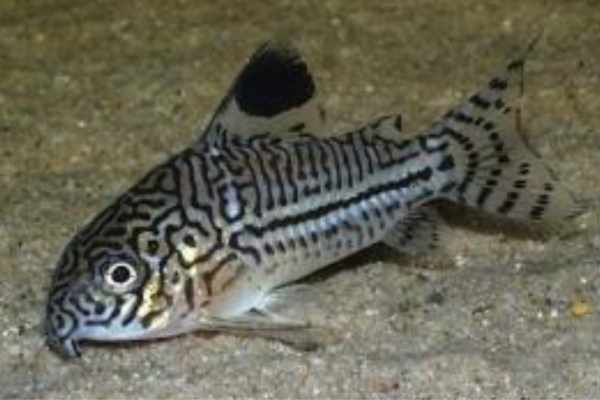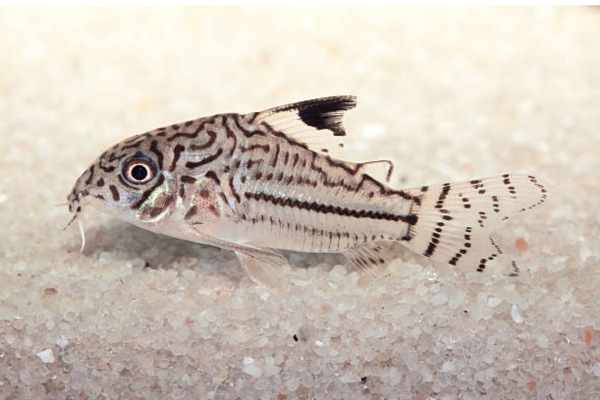Corydoras catfish are popular aquarium fish known for their unique appearance and peaceful nature. Within the Corydoras family, two species often cause confusion due to their similar names and physical characteristics: False Julii Cory (Corydoras trilineatus) and Julii Cory (Corydoras julii). In this comprehensive comparison, we will delve into the distinct features of these two species, including their physical appearance, natural habitats, behavior and characteristics, care requirements, and provide insights to help aquarium enthusiasts make an informed decision.
Detailed Features of False Juli Cory (Corydoras trilineatus)
False Julii Cory, scientifically known as Corydoras trilineatus, is a fascinating catfish species that adds vibrancy to any aquarium. Let’s explore its unique features in detail:
Physical Appearance
False Julii Cory possesses a sleek, elongated body with an average size ranging from 2 to 2.5 inches. Its most striking feature is the intricate coloration and patterns on its body. Horizontal dark bands run along the length of its body, accompanied by smaller spots in between. These patterns create an eye-catching contrast against its light-colored base.

Image Showing False Julii Cory Catfish
Natural Habitat
False Julii Cory is primarily found in the freshwater rivers and streams of South America, specifically in the Amazon and Orinoco River basins. They thrive in regions with moderate water flow and sandy or gravel substrates. The dense vegetation and presence of hiding spots are also essential aspects of their natural habitat.
Feeding Behavior
False Julii Cory is a social species that prefers living in groups. They exhibit peaceful behavior and are known for their bottom-dwelling habits. These catfish have a remarkable ability to detect food particles buried in the substrate, which they extract using their sensitive barbels. False Julii Cory is an omnivorous species, feeding on a combination of small crustaceans, insect larvae, and plant matter.
Breeding
During the breeding season, males and females engage in an intricate courtship dance. The female lays her eggs, which are fertilized by the male. The eggs are then deposited on plant leaves or other surfaces in the aquarium. Proper conditions, such as a slightly raised temperature and good water quality, encourage successful breeding.
Care Requirements in Aquariums
To ensure the well-being of False Julii Cory in an aquarium setup, certain care requirements should be met. These include:
- Providing a tank with a minimum capacity of 20 gallons for a small group of False Julii Cory.
- Maintaining a temperature range of 72-79°F (22-26°C) and a pH level between 6.0 and 7.5.
- Implementing a well-filtrated system to maintain clean water conditions.
- Offering a substrate with fine sand or rounded gravel to simulate their natural habitat.
- Including live or artificial plants, driftwood, and rocks to create hiding places and replicate their natural environment.
- Choosing tankmates carefully, considering peaceful species that inhabit different water levels, such as tetras, rasboras, and peaceful dwarf cichlids.
Detailed Features of Julii Cory (Corydoras julii)
Julii Cory, scientifically known as Corydoras julii, is another captivating catfish species that often confuses aquarium enthusiasts due to its similarity to False Julii Cory. Let’s explore the distinctive traits of Julii Cory:
Physical Appearance
Julii Cory shares a similar body shape and size to False Julii Cory, with an average length of 2 to 2.5 inches. However, its physical patterns and coloration differ. Julii Cory showcases a spotted appearance with a combination of large dark spots and smaller specks scattered across its light-colored body. These spots create a visually appealing mosaic-like pattern.

Image Showing Julii Cory Catfish
Natural Habitat
Julii Cory is native to the freshwater rivers and tributaries of South America, specifically the Amazon River basin. They inhabit areas with slow to moderate water flow, sandy or muddy substrates, and an abundance of vegetation. Similar to False Julii Cory, Julii Cory seeks shelter among plants and rocks in its natural habitat.
Feeding Behavior
Julii Cory shares behavioral traits similar to False Julii Cory. It is a social and peaceful species that thrives in groups. Being a bottom-dweller, Julii Cory actively sifts through the substrate using its barbels to locate food particles. They have an omnivorous diet, consuming small invertebrates, worms, and plant matter.
Breeding
During the breeding season, Julii Cory exhibits courtship behavior, with males actively pursuing females. The female deposits her eggs, which are fertilized by the male. These eggs are then attached to various surfaces, such as plant leaves or the aquarium glass, for incubation.
Care Requirements in Aquariums
Creating a suitable environment for Julii Cory in an aquarium entails specific care requirements, including:
- Providing a tank with a minimum capacity of 20 gallons for a small group of Julii Cory.
- Maintaining a temperature range of 72-79°F (22-26°C) and a pH level between 6.0 and 7.5, similar to False Julii Cory.
- Ensuring a well-filtrated system to maintain water quality and clarity.
- Incorporating a substrate that mimics their natural habitat, such as fine sand or rounded gravel.
- Adding live or artificial plants, driftwood, and rocks to create hiding spots and mimic their natural environment.
- Selecting peaceful tankmates that occupy different water levels and have compatible water parameter requirements.
Key Differences between False Julii Cory and Julii Cory
Despite their similarities, False Julii Cory and Julii Cory possess key differences that make them distinguishable from one another:
Physical Appearance: The most apparent difference lies in their patterns. False Julii Cory has horizontal dark bands along its body, while Julii Cory showcases large dark spots and smaller specks, forming a mosaic-like pattern.
Geographic Distribution: False Julii Cory primarily inhabits the Amazon and Orinoco River basins, while Julii Cory is found in the Amazon River basin.
Habitat Preferences: While both species prefer slow to moderate water flow and sandy substrates, False Julii Cory is more commonly found in regions with gravel substrates, while Julii Cory thrives in areas with muddy substrates.
Behavior and Characteristics: While their behavior and feeding habits are similar, variations in courtship rituals and breeding behaviors may occur between the two species.
Care Requirements: Though their care requirements overlap, slight differences may exist due to variations in their natural habitats. These differences might include water temperature preferences or substrate preferences.
Here’s a comparison table highlighting the key differences between False Julii Cory and Julii Cory:
| Features | False Julii Cory (Corydoras trilineatus | Julii Cory (Corydoras julii) |
|---|---|---|
| Common Name | False julii cory, leopard catfish, leopard cory, three-line catfish, three-lined cory, three-stripe cory, trilineatus cory | Julii catfish, julii cory, leopard cory |
| Physical Appearance | Elongated body with dark horizontal bands and smaller spots | Elongated body with large dark spots and smaller specks |
| Geographic Distribution | Amazon and Orinoco River basins | Amazon River basin |
| Habitat Preferences | Moderate water flow, sandy or gravel substrates | Slow to moderate water flow, muddy substrates |
| Social Behavior | Lives in groups, peaceful nature | Lives in groups, peaceful nature |
| Feeding Habits | Omnivorous, sifts through substrate for food particles | Omnivorous, sifts through substrate for food particles |
| Breeding Behavior | Intricate courtship dance, eggs deposited on surfaces for incubation | Courtship behavior, eggs attached to various surfaces for incubation |
| Tankmates | Suitable tankmates are small to medium-sized fish such as dwarf cichlids, danios, gouramis, tetras, rasboras, and other small catfish species. It should not be kept with large or aggressive species. | Suitable tankmates are small peaceful fish such as tetra family, dwarf cichlids, danios, Bettas, Amano Shrimps, Swordtails, Angelfish, and other Corydoras, rasboras, and other small community fish. You should avoid any large or aggressive fish as tankmates. |
| Care Requirements | Tank size: 20+ gallons, temperature: 72-79°F, pH: 6.0-7.5, compatible tankmates | Tank size: 20+ gallons, temperature: 72-79°F, pH: 6.0-7.5, compatible tankmates |
| Lifespan | 10 years | 5 years |
Choosing between False Julii Cory and Julii Cory
When deciding between False Julii Cory and Julii Cory, several factors should be considered:
Aquarium Setup Considerations: Take into account your existing or planned aquarium setup, including tank size, substrate type, and preferred plants. Consider which species’ appearance and patterns will complement your overall aesthetic vision.
Personal Preferences: Consider your personal preferences for the mosaic-like pattern of Julii Cory or the banding pattern of False Julii Cory. It’s essential to choose a species that resonates with your preferences and aligns with your vision for your aquarium.
Availability and Price: Availability and pricing may vary depending on your location and the fish stores in your area. Research local suppliers or online retailers to determine which species is more readily available and fits within your budget.
Conclusion
In conclusion, False Julii Cory (Corydoras trilineatus) and Julii Cory (Corydoras julii) are captivating catfish species with distinct characteristics. While they share similarities in physical appearance, behavior, and care requirements, differences in patterns, geographic distribution, habitat preferences, and subtle variations in behavior set them apart. By considering these factors, aquarium enthusiasts can make an informed decision when choosing between False Julii Cory and Julii Cory, ensuring the right fit for their aquarium setup and personal preferences. Regardless of the choice, both species bring vibrancy, activity, and a peaceful nature to any well-maintained aquarium.

